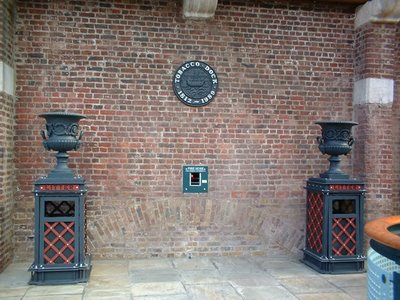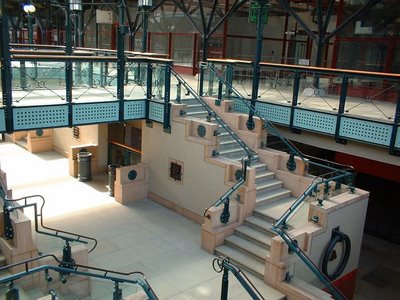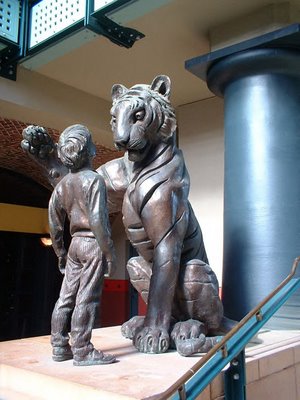Tobacco Dock
The first thing that hits you as you walk into this aging architectural wonder is the ghostly absence of people. This complete lack of people is made even more acute by the mannequins that lay in a heap behind the now empty shop windows as though a massacre has occurred and the bodies have all been buried and frozen behind glass.
It has a chilled spooky feel about the place as history hangs heavy from the cowering ceiling and the spectral sounds of Victorian boot heels echo dimly in your subconscious. Your footfall reverberates and shadows play upon your eye and mind.
What the hell happened here?
The current owners paid eleven million pounds for this incredible slice of history and then spent a further seventy on refurbishing it with shops and bars only to let it all go to rack and ruin. Well, not quite, it still has the vestiges of life pumping through it as piped music plays out softly and security guards still patrol and the one remaining shop, Frank. N. Steins (oh boy!) still sells sandwiches and chilled drinks.
The imagination runs riot with the magic wonders you might perform if you could but own it.
Maybe a Covent Garden cafe/restaurant mentallity with a dash of street entertainers. Perhaps a fruit and veg market down one of the corridors with some posh shops and a bar and maybe a museum of East London Antiquities. An art gallery and also, on the upper level a clutch of commercial and business offices - solicitors, estate agents, financial advisors.
It could work couldn't it?
Dream on old son, dream on.
Let's see if the following articles that we faithfully re-publish here throw any light on the dream nightmare that is and was...
"Tobacco Dock, Wapping"

"Something of an oddity, this one. Redeveloped as part of the massive investment in London's old docks areas during the 1980s, £70 million was spent on turning the smallish Tobacco Dock into a split-level complex of shops, bars and restaurants. However it never really took off and by the mid-90s many of the traders were leaving and by the turn of the millennium it was as good as deserted. However it's still well-kept and looked after, and open to the public Monday to Saturday.
During the week there is a steady stream of workers from the nearby News International offices and the ever-present building sites, but on a Saturday it is truly deserted. Despite the fact that many of the shops have been empty for years, the fact that the place is clean, tidy, and free of grafitti and vandalism makes it seem like they only left a week or two ago. It can be a very odd feeling walking around here on a Saturday, as if you've wandered into a shopping mall the day after all humans vanished from the planet!

At the north entrance to Tobacco Dock, close to the road now known simply as The Highway, stand two bronze statues: one is of a bear reared up on its hind legs, the other is off a young boy standing in front of a tiger. The plaques accompanying these statues read as follows:
Over a hundred years ago on what was then called Ratcliffe Highway near to this spot stood Jamrach's Emporium. This unique shop sold not only the most varied collection of curiosities but also traded in wild animals such as alligators, tigers, elephants, monkeys and birds. Jamrach's was known to seafarers throughout the world who, when their ship docked in London, would bring artefacts from distant lands in the knowledge that Mr Jamrach would be a willing purchaser. The animals were housed in iron cages and were well looked after until they were bought by zoological institutes and naturalist collectors.
In the early years of the nineteenth century a full grown Bengal tiger, having just arrived at Jamrach's Emporium, burst open his wooden transit box and quietly trotted down the road. Everybody scattered except an eight year old boy, who, having never seen such a large cat, went up to it with the intent of stroking his nose. A tap of the great soft paw stunned the boy and, picking him up by his hacket, the tiger walked down a side alley. Mr Jamrach, having discovered the empty box, came running up and, thrusting his bare hands into the tiger's throat, forced the beast to let his captive go. The little boy was unscathed and the subdued tiger was led back to his cage."

For more from this excellent site go to...http://www.deepsea.force9.co.uk/london.html
^^^^^^^^^^^^^^^^^^^^^^^^^^^^^^^^^^^^^^^^^^^^^^^^^^^^^^^^^^^^^^^^
"Tobacco Dock is an architecturally significant warehouse in Wapping in London's Docklands. It is a listed building and is designated Grade I, which is the highest grade.
The warehouse was constructed in approximately 1812 and served as a store for imported tobacco. It is a brick building with many brick vaults and some fine ironwork. It was adjacent to the particular set of docks named London Docks, which have largely been filled in.
In the late 1980s or the 1990s the building was converted into a shopping centre but the scheme was unsuccessful and it went into administration. The property is not in a major retail area and has only moderately good public transport access. Since the late 1990s the building has been almost entirely unoccupied, and a plan to convert it into a factory outlet did not come to fruition. The whole building is occasionally used for large scale corporate events such as the Vodafone and ABN AMRO 2005 annual staff 'party'.
The building has been well maintained and is still open to the public, but in 2003 English Heritage placed it on the Buildings at Risk register. In 2004 they arranged a meeting with the owners, a Kuwaiti investment company called Messila House to find a way forward. An English Heritage spokesman commented, "We see Tobacco Dock as a future priority because it is too large and important a site to be left standing empty. It is one of the most important buildings in London and if brought back into use it would reinvigorate the whole area." (Regeneration magazine 12 November 2004). In 2005 the owners announced that they were working on a mixed use scheme for Tobacco Dock which might incorporate a four-star hotel, shops and luxury apartments. The architects are Hellmuth, Obata and Kassabaum."
For more information and to see where this text originates please visit here...
http://www.answers.com/topic/tobacco-dock
^^^^^^^^^^^^^^^^^^^^^^^^^^^^^^^^^^^^^^^^^^^^^^^^^^^^^^^^^^^^^^^^^^
"The name of Wapping probably dates back to the Saxon period and is thought to have been derived from a man called Waeppa. In Saxon times, this would have been a marshy area beside the Thames and few people lived here until the 14th century, when some landing stages and wharves were built."
Another interesting site is this...http://www.exploringeastlondon.co.uk/Wapping/Wapping.htm

0 Comments:
Post a Comment
<< Home